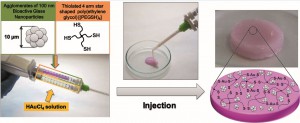Recent advancements in tissue engineering have led to the fabrication of complex materials that may be used as surrogates for heart, neuronal, bone and cartilage tissue regeneration. A vast majority of engineered tissues are composed of a three-dimensional scaffold at its core, layered with growth stimulating agents, that collectively nurture and support cell growth.
In a study by Gantar and colleagues at the Jozef Stefan Institute, Department for Nanostructured Materials in Slovenia, a team of researchers created an injectable hydrogel as a potential biomaterial for bone tissue regeneration. They further demonstrate that the hydrogel is capable of self-healing and supports the growth of cells derived from human bone tissue.
Hydrogels based on reversible covalent bonds allow the material to rearrange its structure permanently. This forms the basis for self-healing. A potential drawback is that the conditions (temperature and pH) required to form these bonds to form are not suitable for supporting bone cell growth. Having recognized this limitation, the team decided to develop a liquid hydrogel that transitions to a gel-like state at a pH suitable for cell growth and proliferation. Further, the hydrogel was infused with bioactive glass (BAG) nanoparticles – a silica-based material known to support bone cell growth.
The study also characterizes the physical (elastic properties, compression) and biological (degradation, cytotoxicity) features of the injectable hydrogel. The study finds that the BAG nanoparticles do not drastically alter the physical and biological properties of the hydrogel and suggest that the combination is well suited to support bone cell growth. The team proposes that their efforts will contribute toward the development of an injectable material that will scaffold bone cells within the host and promote self-repair.
Read the full article here:
Injectable and self-healing dynamic hydrogel containing bioactive glass nanoparticles as a potential biomaterial for bone regeneration
Ana Gantar, Nataša Drnovšek, Pablo Casuso, Adrián Pérez-San Vicente, Javier Rodriguez,c Damien Dupin, Saša Novakab and Iraida Loinazc
RSC Adv., 2016,6, 69156-69166
DOI: 10.1039/C6RA17327F











